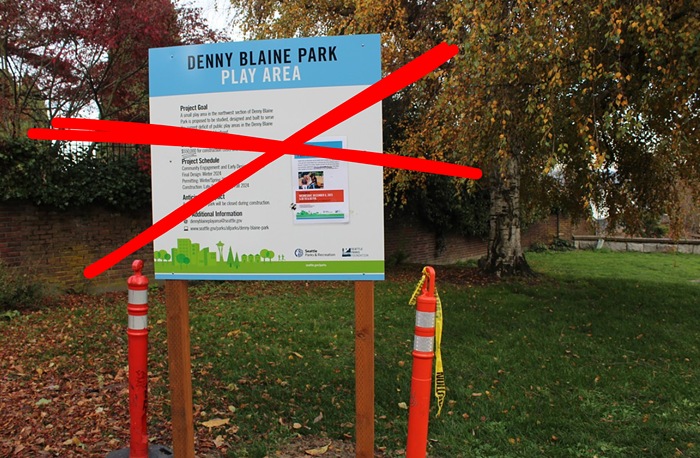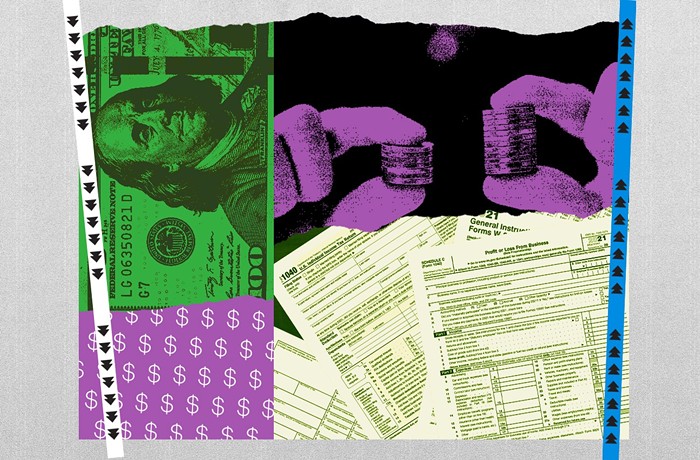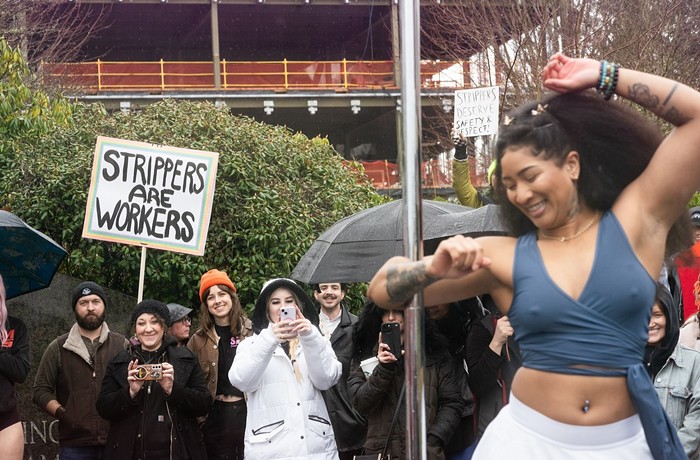Seventeen thousand people losing health care, scores of elderly people forced into nursing homes, emergency rooms packed with refugees from state health care programs, a 13 percent jump in tuition, and class sizes skyrocketing.
That's only some of what will happen this year in Washington State.
On April 9, the state house introduced a two-year budget that will fill our $5.1 billion shortfall with money taken largely from programs that help students and the most vulnerable people in the state. Three examples of what's being cut: $1.4 billion that was intended to reduce class size and pay teachers, $500 million from higher education, and more than $450 million in medical services for the sick and elderly. The Democrats who control both houses in Olympia released what is, in essence, a Republican budget.
And it will probably get worse.
The taxes that we pay as a share of the state's overall economy have been shrinking, falling from 6.9 percent of personal income in 1995 to 4.7 percent today, according to the Washington State Economic and Revenue Forecast Council. In other words, the state government has atrophied over the past 15 years due to a structural taxation deficit.
"I don't even think it's moral," Governor Chris Gregoire said of her proposed budget in December.
Of course, Gregoire and other Democrats had ample warning that the state was circling the drain. They even had a clearly drafted solution to stop the "immoral" budget they are now attempting to pass.
The legislature created the Washington State Tax Structure Study Committee to study the problem and report back in 2001. The ominous verdict a decade ago: Unless we made drastic changes, our state would lean too heavily on the poor (who pay a disproportionately high sales tax compared to their income), while the overall revenue would drop, accounting for inflation, requiring the state to sever lifelines to the poor and elderly. "The committee concludes that our current system is fundamentally inequitable to low- and middle-income people, unfair to many businesses, and subject to sharp fluctuations in revenue," wrote the committee led by William H. Gates Sr. "If this current trend continues, our tax structure will be even less adequate in the future."
We're now living in that "inequitable" and "less adequate" future.
As the committee recommended, the legislature could fix our regressive state system by instituting an income tax. After all, voters are on their side. Last December, an Elway Poll found that 58 percent of Washington voters would support a high-earners income tax, provided it came with a constitutional guarantee that it wouldn't be extended to people at lower incomes (that is different than the income tax initiative that voters rejected last November). Or the legislature could have closed hundreds of millions of dollars in tax loopholes (like those for Wall Street banks, private jet owners, and plastic surgery). Although Tim Eyman's Initiative 1053 requires a nearly impossible two-thirds majority of the legislature to raise taxes, there are ways to circumvent those rules and challenge them in court. Legislators didn't even try any of these things.
Instead, the Dems fucked over the poor, the old, and the students. The state house has already approved this all-pain budget. The state senate may act by the time this paper hits the streets.
Without any leadership in Olympia—if they couldn't muster action in the last two budget cycles, it seems doubtful they ever will—this problem will worsen in perpetuity. There is no happy ending. This is a glimpse of what it looks like.
In the Homes of the Elderly
Rhonda Paul's job takes her inside trailer homes, tiny apartments, and rickety houses all over Snohomish County. For $10.41 an hour, she tends to low-income people, many of them elderly, who are dealing with debilitating conditions ranging from Alzheimer's to Huntington's disease to cancer. If it weren't for the state funding that pays Paul to come to their homes and bathe them, prepare their meals, and make their beds, many of them wouldn't be able to live independently.
The budget passed by the state house on April 9 would cut funding for home health care services by $100 million (that's a 10 percent cut from the $1 billion Washington currently spends each biennium on these services). That follows previous cuts; if the most recent budget proposal becomes law, lawmakers will have reduced home health care funding by 14 percent since 2009.
But as money dries up, the elderly population is increasing. "As the baby boomers start to move into the long-term-care system, you're certainly seeing growing demand for home-care services," says Adam Glickman, spokesman for SEIU Local 775. "More and more of them are going to end up in nursing homes—and that's actually a significantly higher cost to the state."
Medical privacy laws prohibit Paul from discussing her own clients, but she's heard of low-income elderly people being forced into nursing homes because their home health care hours were slashed so deeply that they could no longer manage to live in their own houses. That kind of sudden change "can shorten their lives," Paul says. "Just how many people have to die before they admit the cuts have gone too far?"
On College Campus
If there's one thing the new house budget will create a surplus of, it's the number of dreaded "thin letters" flooding the mailboxes of local college applicants. And with state funding for public colleges and universities collapsing, this annual orgy of adolescent disappointment is only bound to grow worse.
Facing a more than 50 percent cut in state support over the past two budgets, the University of Washington recently eliminated 150 slots for in-state freshmen. Why? To make room for more profitable out-of-state students and the $25,317 premium they bring in—almost three times the discounted resident tuition price tag of $8,702. But when local prospects and their parents howled in outrage at the news, UW officials attempted to deflect criticism by pointing to the hundreds of new slots being created at its satellite campuses in Bothell and Tacoma.
Okay, there are indeed hundreds more slots opening. So how is UW Tacoma recruiter Curtis Black dealing with his increased workload? By heading off to California of course, to lure in, you guessed it, retail-paying out-of-staters.
"They didn't bat an eye at the price," Black says about the Californians eager to pay whatever it takes to help their children escape the mess at their state's once proud public university system. California has taken a different approach to higher-education rationing, accepting more applicants than there are available slots in 100- and 200-level prerequisites. The result is that it can now take five or six years for students to get into the courses they need to graduate, and disgruntled faculty are "fleeing like crazy," according to Black.
Out-of-state recruitment is new territory for UW Tacoma, where nonresidents currently make up less than 1 percent of the student body. But facing the same budget crunch as the Seattle campus, the branches see little alternative. UW Bothell now has a full-time recruiter in California, and next year, UW Tacoma plans to expand its recruitment to Montana. Black says that administrators are careful not to put a target on out-of-state recruitment numbers, but it's quickly becoming an important new source of revenue.
And how could it not? The house budget cuts $482 million from higher education, $204 million from the UW alone, and that's on top of hundreds of millions of dollars of cuts in previous budgets. Just a few years ago, the state picked up 72 percent of the cost of resident students; last year, the state's share slipped under 50 percent for the first time in history; and under the new budget, it would fall to 28 percent. In total dollars, state higher-education funding now stands where it was 20 years ago, at a time when its four-year colleges served 32,000 fewer students. As a percentage of our state economy, we spent $15.53 per $1,000 of personal income on higher education back in 1974. Today, we spend only $5.48—and falling.
Not even years of double-digit tuition increases (13 percent annually in 2012 and 2013) can keep pace with this stunning record of disinvestment, meaning that students are gradually paying more while getting much, much less. Which is exactly how California found itself in its current higher-education crisis.
"As California goes, so goes the rest of the nation," Black laments, anticipating the day when Washington's public universities won't look like such a good deal to out-of-state recruits. As it stands, Washington already exports more students than it imports, with many of our best and brightest failing to return.
What does all this mean for local students?
Most college advisers now suggest applying to several universities in pursuit of a non-thin letter, and Black urges prospective students to strongly consider starting at one of our state's many two-year community colleges.
In the Emergency Room
After 15-year-old Casey Shaw broke his leg at a rock show in 2009, his mom drove him to Highline Medical Center in Burien. His emergency-room tab and subsequent months of physical therapy were picked up by Washington Basic Health, the state-funded medical insurance program that costs a fraction of private insurance. "I calculated it—it would've taken our entire summer income to pay for it [out of pocket]," says his mother, Sharon Shaw, who makes kaleidoscopes with her husband and sells them at Pike Place Market.
Shaw pays $280 a month to Basic Health, but comparable private coverage would range from $800 to $1,500 a month. "Insuring ourselves on the open market is virtually impossible," she says.
But the Shaw family may lose their coverage.
This year, the house budget is slated to cut $108 million from Basic Health, booting an estimated 17,000 people from the program (a combination of seniors, immigrants, and others who don't fit within increasingly tight eligibility parameters). This is part of a long trend of Basic Health, which has cut over 70 percent of its patients since its peak in 2002.
Without coverage, those 17,000 people—lacking insurance for primary-care physicians or clinics—won't seek medical care when they need it. Which means they'll end up in the emergency room more often at the public's expense. Uh, some cost-saving measure.
"Any time people become uninsured, there's a huge impact on ERs," explains Cassie Sauer, spokeswoman for Washington State Hospital Association. As it stands, the emergency room at Harborview Medical Center treats 180 people a day on average. In an 18-month statewide study conducted by the association, 17.9 percent of the 2.6 million recorded ER visits were considered avoidable (including dental and mental-health visits). That percentage increases as the number of uninsured rises, says Sauer. Hospitals are obligated to care for people who show up, which means "ultimately, the hospital will shoulder the cost of those visits... and in order to keep the doors open, they'll increase rates for people who do have insurance."
What's the prognosis for Basic Health?
Between January 2009 and today, the state has cut enrollment for Basic Health from more than 106,000 people to 41,200. That's roughly 60 percent in two years. It's impossible to know what future budgets may hold, but the underlying problems with Washington's tax structure remain—and, again, Democrats prove annually unwilling and incapable of fixing those structural problems—so Basic Health is dwindling. At this rate, it will be gone by 2014.
Meanwhile, the house cut $100 million from Disability Lifeline, the program that helps people who are too ill or injured to work to cover their bills. The budget also imposes a three-visit cap on the number of "unnecessary" emergency-room visits for people on Medicaid. Who will suffer? Medicaid covers about 700,000 infants and children in the state. Among the "unnecessary" visits outlined by the nonemergency list: diabetic comas, hernias, convulsions from high fever, major difficulty breathing, rectal/anal hemorrhage, and severe hemorrhaging in infants.
"The legislature is essentially legislating child neglect," says Sauer. "Not taking one's child for treatment for the severe conditions on the list would result in a report to Child Protective Services. Imagine the public outrage if a family kept a child home who had gone into a diabetic coma or had brain damage from convulsions."
In the Forest
In December 2007, when rains barreled down on the clear-cut mountains surrounding the Upper Chehalis Basin, 730 landslides filled the river below with mud and debris, contributing to a historic flood that caused $57 million worth of damage in Lewis County. Officials at the state's Department of Natural Resources (DNR) had often noted the "unstable soils" on the slopes, but did nothing to stop the harvest, a failure that became a potent issue in current commissioner Peter Goldmark's 2008 victory over then-incumbent Doug Sutherland.
The DNR is charged with the enormous task of enforcing regulations on 7.9 million acres of private timberland, while providing fire protection for 12.7 million acres of forest via the largest fire department in the state. Like a slew of other low-profile state agencies and departments, it does of all this on an ever-shrinking budget: from $54 million annually in the 2007–09 biennium to $34 million annually in the 2011–13 recently passed house budget, a 37 percent cut.
Already, staff has been slashed 11.5 percent, from 1,356 full-time employees in 2009 to 1,199 in 2010, and with more cuts looming. This leaves less than one employee per 10,000 acres to manage timber sales and grazing rights, fight fires, patrol forests, preserve recreational access, and—perhaps most importantly for those downstream—oversee and enforce rules on private timberlands like those in the Upper Chehalis Basin.
"Not enforcing the rules could have devastating impacts," Goldmark warns, resulting in "flooding, dangerous landslides, and negative impacts to our drinking water." But the more the state cuts Goldmark's budget, the more his hands are tied.
In the Artist's Studio
So many small groups and individuals are supported by the arts-funding agency 4Culture, it's hard to know where to start (Trimpin, Stokley Towles, New Century Theatre Company, NewsWrights United, Hidmo, David Nixon, the New Mystics, Scot Augustson, and bunches more). As of press time, legislators have still failed to embrace a bill to save 4Culture. That bill, arts proponents insist, won't even cost the state any money, since it's asking to extend already-existing hotel taxes in King County—which will soon finish their job of paying for stadium expenses—to go toward arts and heritage. If it doesn't pass, says Jim Kelly of 4Culture, "basically, it would end funding for culture in King County."
On the Road
This year, we're laying more asphalt than ever. That's right: While turning its back on the poor, the old, the sick, the young, and the forests, our state will spend more in this 2011–2013 biennium than ever before on roadway construction. According to the senate's transportation budget, the unprecedented $8.9 billion package includes 700 projects, "with $4.2 billion of that amount for actual construction, a record amount for Washington." (The previous three transportation budgets have been $1.5 billion to $3 billion less.)
Why so flush with cash now? The 20,000 lane miles of roadway managed by the state are funded largely by designated gas taxes. Washington collects 37 cents on every gallon (while the Feds collect another 14 cents) and it's largely bonded for highway projects. Among the big tickets this year: $1.2 billion to widen and replace the 520 bridge (with no light rail accommodations), $917 million to replace the Alaskan Way Viaduct with a deep-bore tunnel, and about a dozen improvements to I-5 and I-90.
Meanwhile, lawmakers are cutting and tapping money from other sources. The biggest hit is $30 million from Washington State Ferries. As for new money: a proposed $100 fee for electric cars. If that sits ill with your hippie heart, it may be because the biggest cut to our transportation budget is taken from a public transit system (ferries), while the new money is coming from the most environmentally friendly vehicles on the road (electric cars).
Eric de Place, a senior researcher at the Sightline Institute, acknowledges that jailbreaking all that dedicated road money would require a political feat. "But there is not any principle for why the gas-tax money should be restricted just to highways," he says. Low- and middle-income workers spend a higher proportion of their salaries on gas taxes and transportation, he adds. "I think it is immoral to be spending huge sums of money on car infrastructure while we leave behind the kids, the sick, and the elderly." ![]()




















